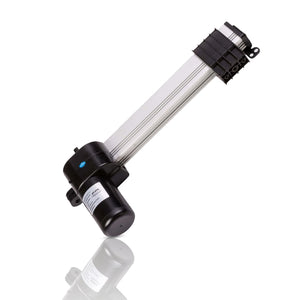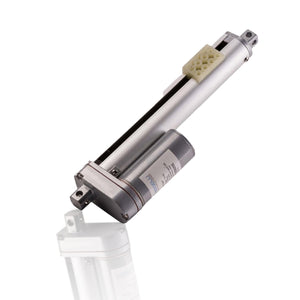
Track Actuators
Track linear actuators are like rod-style linear actuators as they consist of a motor, gearbox, and lead screw, but instead of a rod, these actuators use a sliding carriage. This sliding carriage moves along the track of the lead screw as it rotates giving these actuators their name. Because of this, the stroke of a track linear actuator is equal to the length of the lead screw. This means these actuators have a fixed length. It makes them easier to design around than rod-style linear actuators, but it also means they lack the telescopic motion that rod-style actuators have.

Our Track Linear Actuators are suited for carrying loads along the length of the actuator
In the realm of linear motion, our track linear actuators stand out for their efficiency, engineered specifically for seamless load transportation along their length. Unlike conventional rod-based actuators, our track linear actuators offer a compact design, eliminating the need for excessive space allocation. By securely mounting the load onto the sliding carriage, these actuators enable effortless traversal along the actuator's body, facilitating smooth and precise movement.
Moreover, the track design inherently offers advantages over traditional rod-based actuators. By distributing the load along the length of the actuator, track linear actuators provide enhanced stability and uniform motion, minimizing vibrations and ensuring consistent performance even in demanding environments. Additionally, the absence of extended rods reduces the risk of bending or misalignment, prolonging the lifespan of the actuator and minimizing maintenance requirements.
Whether deployed in industrial automation, robotics, or assembly lines, our track linear actuators consistently deliver reliable performance, enhancing workflow efficiency and optimizing operational productivity. Experience the precision and reliability of our track linear actuators, setting new benchmarks in load transportation across diverse applications.

What are the Differences Between Track Linear Actuators and Rod Linear Actuators?
When comparing track linear actuators to their rod-based counterparts, it's crucial to understand the distinct mechanisms driving their linear motion. While both styles of actuators harness electrical energy to generate linear motion through a motor and gearbox, the manner in which this motion is delivered sets them apart.
In a standard rod linear actuator, the rotational motion from the gearbox is transformed into linear motion via a lead screw mechanism. This lead screw extends and retracts the rod, providing the desired linear movement. Conversely, track linear actuators also utilize a lead screw for this conversion, but instead of a rod, they employ a sliding carriage. This carriage smoothly traverses along the length of the lead screw, delivering linear motion without the telescopic extension characteristic of rod linear actuators.
By foregoing telescopic motion, track linear actuators offer a fixed length along which the carriage slides, enhancing stability and precision in linear motion applications. This design ensures consistent performance and eliminates concerns related to rod misalignment or bending, common drawbacks associated with traditional rod actuators.
Beyond this fundamental difference, it's worth noting that track linear actuators typically boast comparable specifications to their rod actuator counterparts. From available stroke lengths to load capacities, these actuators offer similar performance parameters, making them versatile solutions across a wide range of applications.

Where are Track Linear Actuators used?
Track linear actuators find versatile applications across various industries, offering seamless sliding motion tailored to specific needs. While they excel in sliding applications, their suitability for indoor use, owing to a lower IP rating, makes them particularly prevalent in certain environments.
In educational settings, track linear actuators play a pivotal role in facilitating interactive learning experiences. They are commonly deployed in schools for sliding whiteboards and chalkboards, enhancing classroom dynamics and enabling educators to adapt spaces effortlessly. Similarly, in the realm of interior design and customization, track linear actuators are indispensable for motorized sliding doors in custom cabinetry, elevating both functionality and aesthetics.
Moreover, track linear actuators are integral components in industrial machinery, enhancing precision and efficiency in manufacturing processes. Applications such as CNC machines and 3D printers leverage track linear actuators to position components over fixed lengths with unparalleled accuracy, ensuring optimal results in every operation.
When evaluating whether to utilize a track linear actuator over a rod-based counterpart, consider scenarios where movement is predominantly unidirectional and telescopic motion is unnecessary. This makes track linear actuators ideal for applications demanding consistent linear movement without the complexities of telescopic extension.
At Firgelliauto, we offer a comprehensive range of track linear actuators to cater to diverse needs. From heavy-duty track linear actuators to compact mini track variants, our solutions are meticulously crafted to meet the motorized sliding requirements of your next project, ensuring seamless functionality and unmatched reliability.
.
Frequently Asked Questions
Track linear actuators are uniquely suited for applications requiring precise and controlled movement along a path. In robotics, track linear actuators enable robots to navigate dynamic environments and execute intricate tasks with accuracy, such as pick-and-place operations and assembly. In manufacturing, they facilitate the efficient transportation of components along assembly lines, enhancing productivity and streamlining production processes. Moreover, track linear actuators find extensive use in medical equipment for tasks like positioning imaging devices and patient handling systems with utmost precision. They are also integral components of entertainment industry setups, enabling smooth and dynamic movement of stage props, lighting fixtures, and camera equipment during live performances and theatrical productions. From agricultural machinery to laboratory automation, track linear actuators offer unmatched versatility, reliability, and flexibility in motion control, making them essential for a wide range of applications.
Our track linear actuators are designed with an IP Rating of 43. This rating signifies that our actuators offer protection against solid objects greater than 1 millimeter in diameter and protection against water spray at angles up to 60 degrees from vertical. The IP43 rating ensures that our actuators are suitable for indoor applications where they may be exposed to light dust and water splashes. While they may not be fully sealed against water ingress, they provide adequate protection for a wide range of industrial and commercial environments.
Top Blog Posts for Track Linear Actuators
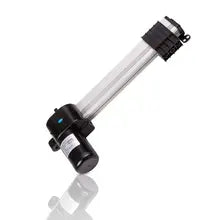
Look into the inner workings of these crucial components, from dissecting different types to uncovering the reasons behind their unique behaviors. Whether you're a novice...
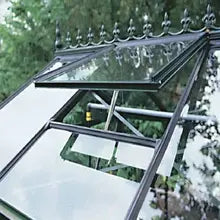
From decoding the IP rating table to understanding its relevance in different industries, including for linear actuators, this article provides invaluable insights for all. This...
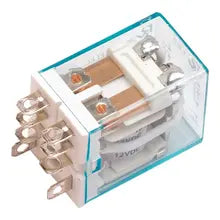
Explore the basics of reversing polarity and uncover its effects on linear actuators. We'll examine real-world applications, including the influence of polarity reversal on actuator...

Delve into the fascinating history that has revolutionized industries worldwide. Discover how automation has transformed manufacturing, from the invention of the assembly line to the...
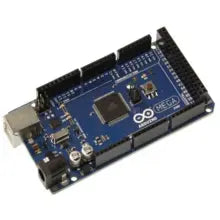
Unfortunately, you can't simply connect your Arduino directly to your linear actuator and expect it to work seamlessly. Prior setup is necessary. We'll guide you...
